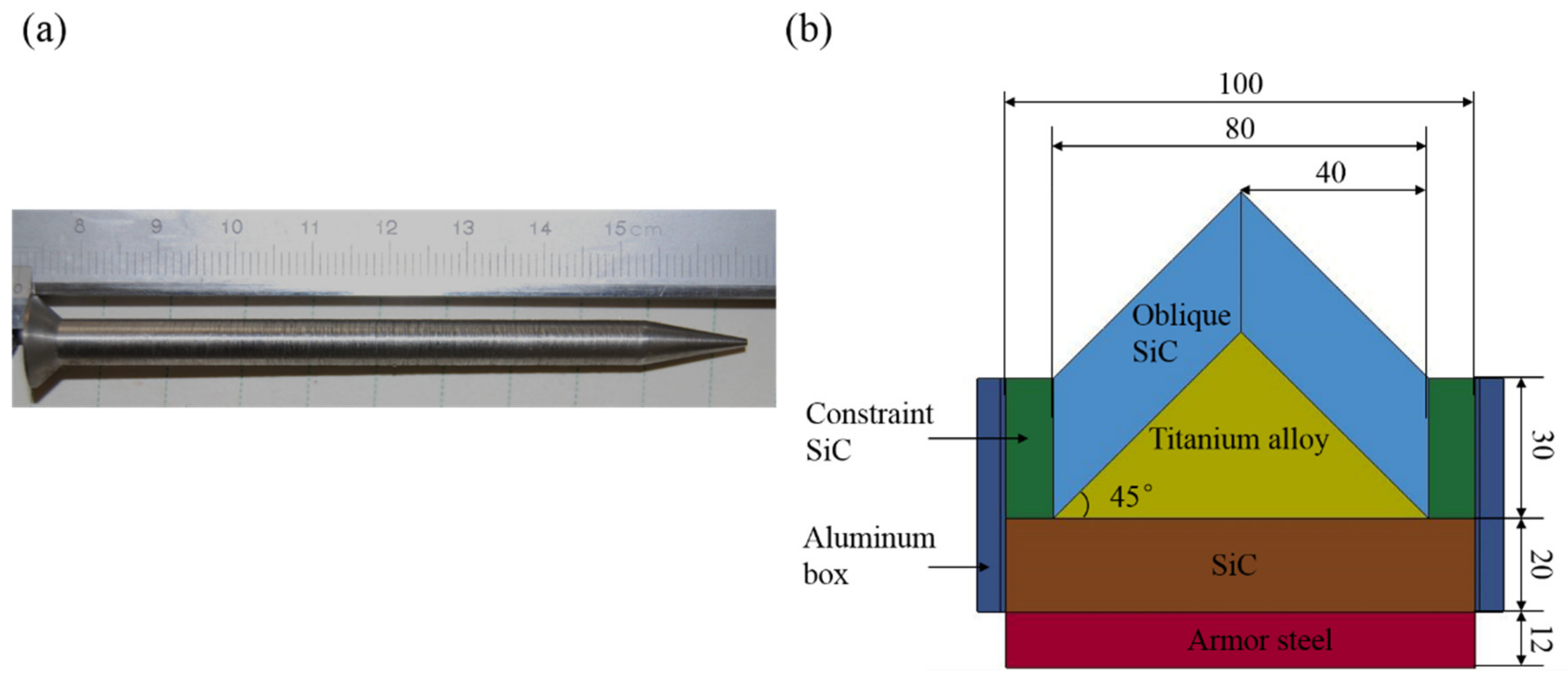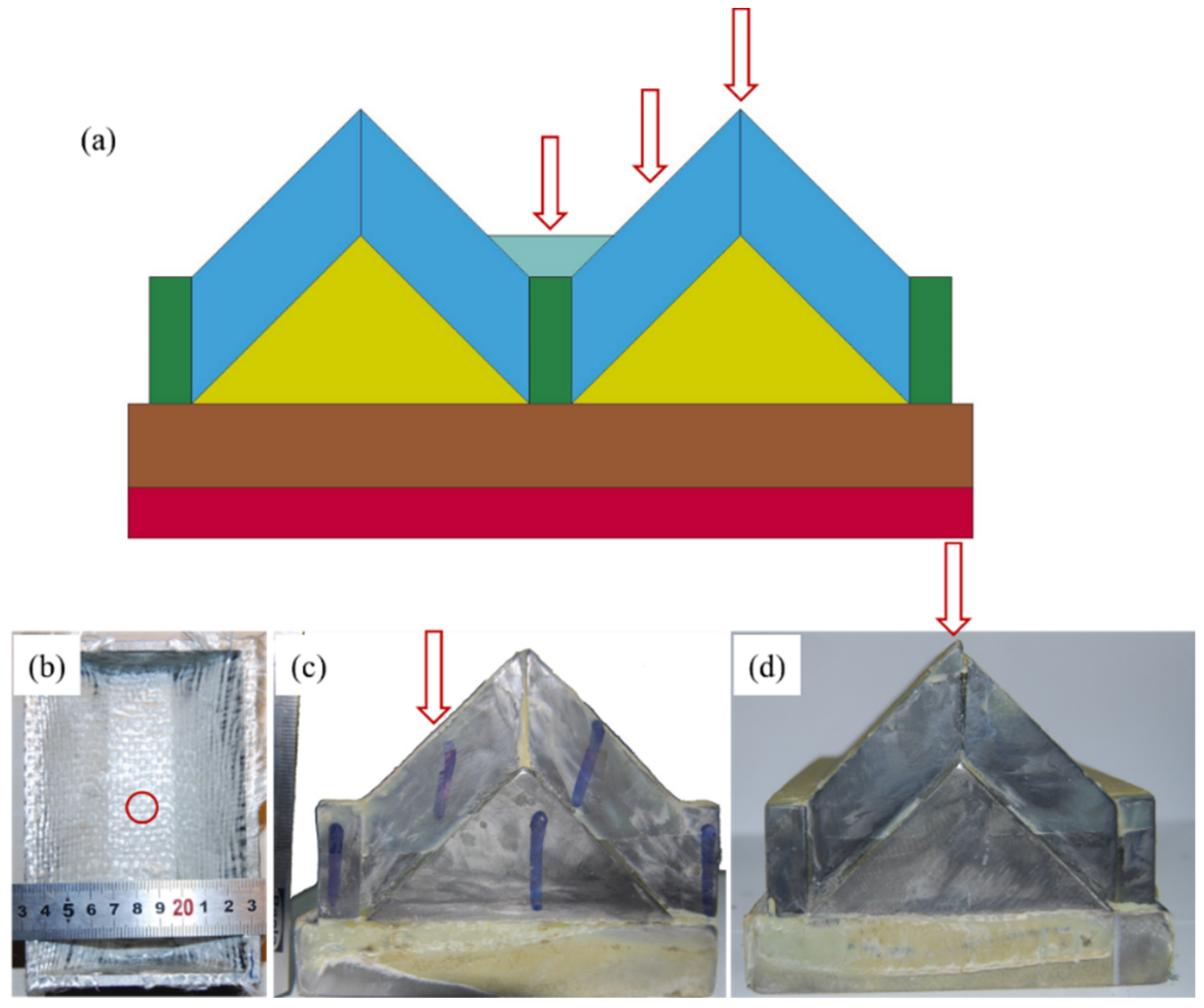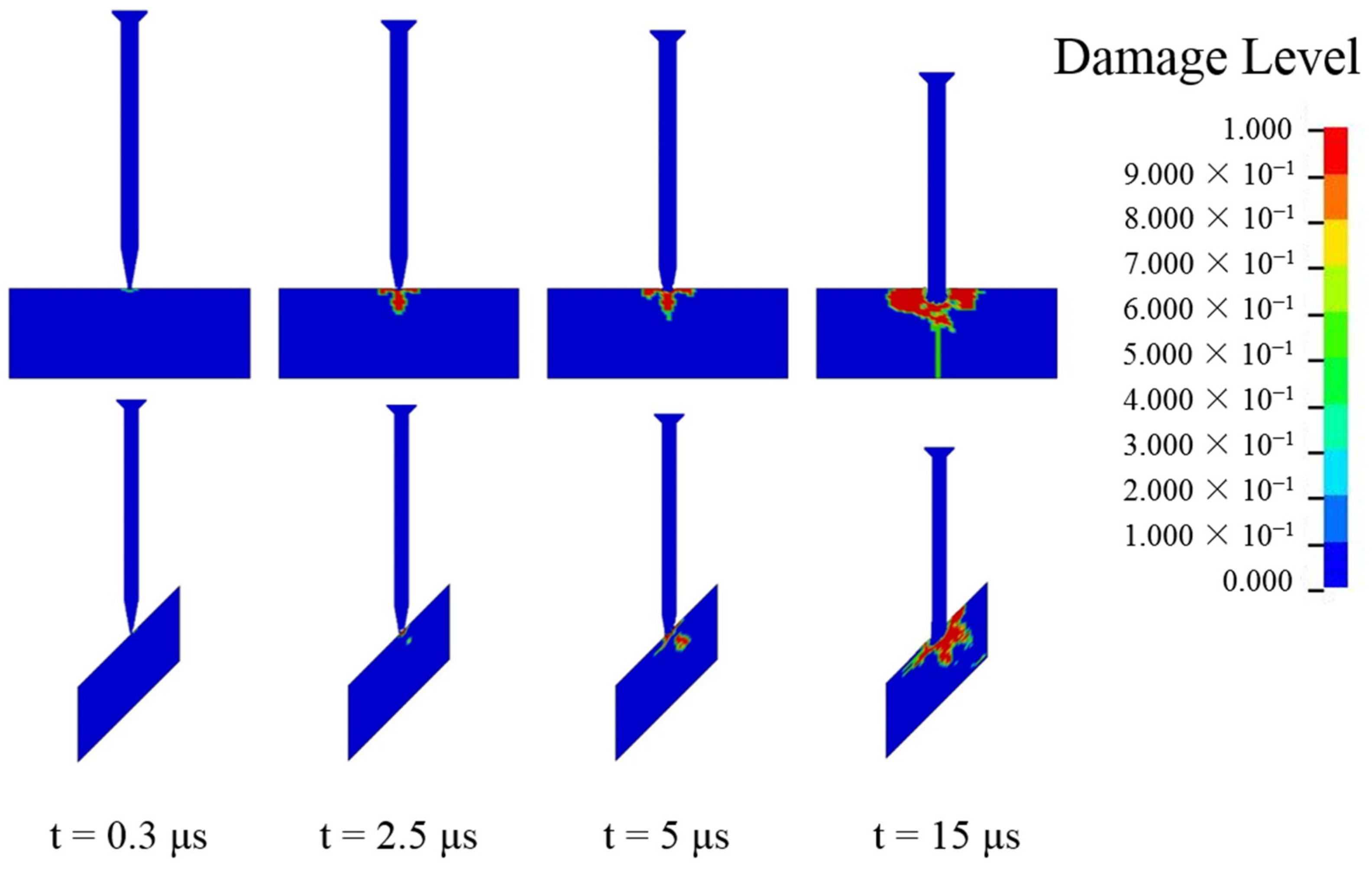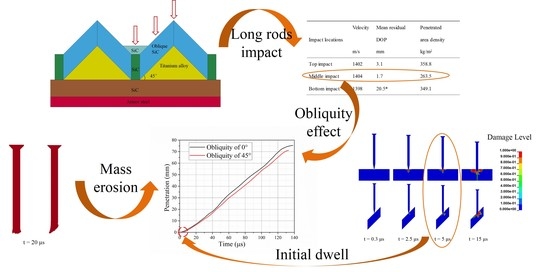Ballistic Behavior of Oblique Ceramic Composite Structure against Long-Rod Tungsten Projectiles
Abstract
:1. Introduction
2. Experimental Work
2.1. Experimental Set-Up
2.2. Experimental Results
3. Numerical Simulations
3.1. Numerical Model
3.2. Validation of Numerical Model
3.3. Effect of Gap between Ceramics
3.4. Obliquity Effect
4. Conclusions
Author Contributions
Funding
Conflicts of Interest
References
- Johnson, W.; Sengupta, A.K.; Ghosh, S.K. High velocity oblique impact and ricochet mainly of long rod projectiles: An overview. Int. J. Mech. Sci. 1982, 24, 425–436. [Google Scholar] [CrossRef]
- Gee, D.J.; Littlefield, D.L. Yaw impact of rod projectiles. Int. J. Impact Eng. 2001, 26, 211–220. [Google Scholar] [CrossRef]
- Rosenberg, Z.; Ashuach, Y.; Dekel, E. More on the ricochet of eroding long rods—Validating the analytical model with 3D simulations. Int. J. Impact Eng. 2007, 34, 942–957. [Google Scholar] [CrossRef]
- Rosenberg, Z.; Ashuach, Y.; Yeshurun, Y.; Dekel, E. On the main mechanisms for defeating AP projectiles, long rods and shaped charge jets. Int. J. Impact Eng. 2009, 36, 588–596. [Google Scholar] [CrossRef]
- Anderson, C.E.; Behner, T.; Hohler, V. Penetration Efficiency as a Function of Target Obliquity and Projectile Pitch. J. Appl. Mech. 2013, 80, 031801. [Google Scholar] [CrossRef]
- Subramanian, R.; Bless, S.J. Penetration of semi-infinite AD995 alumina targets by tungsten long rod penetrators from 1.5 to 3.5 km/s. Int. J. Impact Eng. 1995, 17, 807–816. [Google Scholar] [CrossRef]
- Lundberg, P.; Renstrom, R.; Lundberg, B. Impact of metallic projectiles on ceramic targets: Transition between interface defeat and penetration. Int. J. Impact Eng. 2000, 24, 259–275. [Google Scholar] [CrossRef]
- Behner, T.; Anderson, C.E.; Holmquist, T.J.; Orphal, D.L.; Wickert, M.; Templeton, D.W. Penetration dynamics and interface defeat capability of silicon carbide against long Rod impact. Int. J. Impact Eng. 2011, 38, 419–425. [Google Scholar] [CrossRef]
- An, X.; Jie, Y.; Chao, T.; Bo, W.; Hong, G.; Dong, Y. Penetration resistance of hybrid metallic honeycomb structures with ceramic insertions against long-rod tungsten projectiles. Compos. Struct. 2018, 189, 488–497. [Google Scholar] [CrossRef]
- Lee, M. Hypervelocity impact into oblique ceramic/metal composite systems. Int. J. Impact Eng. 2003, 29, 417–424. [Google Scholar] [CrossRef]
- Hohler, V.; Weber, K.; Tham, R.; James, B.; Barker, A.; Pickup, I. Comparative analysis of oblique impact on ceramic composite systems. Int. J. Impact Eng. 2001, 26, 333–344. [Google Scholar] [CrossRef]
- Hetherington, J.G.; Lemieux, P.F. The effect of obliquity on the ballistic performance of two component composite armours. Int. J. Impact Eng. 1994, 15, 131–137. [Google Scholar] [CrossRef]
- Sadanandan, S.; Hetherington, J.G. Characterisation of ceramic/steel and ceramic/aluminium armours subjected to oblique impact. Int. J. Impact Eng. 1997, 19, 811–819. [Google Scholar] [CrossRef]
- Zaera, R.; Sánchez-Gálvez, V. Analytical modelling of normal and oblique ballistic impact on ceramic/metal lightweight armours. Int. J. Impact Eng. 1998, 21, 133–148. [Google Scholar] [CrossRef] [Green Version]
- Hauver, G.E.; Rapacki, E.J., Jr.; Netherwood, P.H.; Benck, R.F. Interface Defeat of Long-Rod Projectiles by Ceramic Armor. In U.S. Army Research Laboratory Report, ARL-TR-3590; U.S. Army Research Laboratory: Adelphi, MD, USA, 2005. [Google Scholar]
- Holmquist, T.J.; Anderson, C.E.; Behner, T.; Orphal, D.L. Mechanics of dwell and post-dwell penetration. Adv. Appl. Ceram. 2010, 109, 467–479. [Google Scholar] [CrossRef]
- Leavy, B.; Krauthauser, C.; Houskamp, J.; LaSalvia, J. Fundamental Investigation of High-Velocity Impact of Ductile Projectiles on Confined Ceramic Targets. In U.S. Army Research Laboratory Report; U.S. Army Research Laboratory: Adelphi, MD, USA, 2006. [Google Scholar]
- Orphal, D.L.; Franzen, R.R. Penetration of confined silicon carbide targets by tungsten long rods at impact velocities from 1.5 to 4.6 km/s. Int. J. Impact Eng. 1997, 19, 1–13. [Google Scholar] [CrossRef]
- Orphal, D.L.; Franzen, R.R.; Charters, A.C.; Menna, T.L.; Piekutowski, A.J. Penetration of confined boron carbide targets by tungsten long rods at impact velocities from 1.5 to 5.0 km/s. Int. J. Impact Eng. 1997, 19, 15–29. [Google Scholar] [CrossRef]
- Westerling, L.; Lundberg, P.; Lundberg, B. Tungsten long-rod penetration into confined cylinders of boron carbide at and above ordnance velocities. Int. J. Impact Eng. 2004, 25, 703–714. [Google Scholar] [CrossRef]
- Lynch, N.J.; Bless, S.J.; Cullis, I.G.; Berry, D. The influence of confinement on the penetration of ceramic targets by KE projectiles at 1.8 and 2.6 km/s. Int. J. Impact Eng. 2006, 33, 390–401. [Google Scholar] [CrossRef]
- Chi, R.; Serjouei, A.; Sridhar, I.; Tan, E.B.G. Pre-stress effect on confined ceramic armor ballistic performance. Int. J. Impact Eng. 2015, 84, 159–170. [Google Scholar] [CrossRef]
- Holmquist, T.J.; Johnson, G.R. Modeling prestressed ceramic and its effect on ballistic performance. Int. J. Impact Eng. 2005, 31, 113–127. [Google Scholar] [CrossRef]
- Lundberg, P.; Renstrom, R.; Andersson, O. Influence of confining prestress on the transition from interface defeat to penetration in ceramic targets. In Proceedings of the 29th International Symposium on Ballistics, Edinburgh, Scotland, 9–13 May 2016; pp. 1973–1976. [Google Scholar]
- Anderson, C.E., Jr.; Royal-Timmons, S.A. Ballistic performance of confined 99.5%-Al2O3 ceramic tiles. Int. J. Impact Eng. 1997, 19, 703–713. [Google Scholar] [CrossRef]
- Holmquist, T.J.; Anderson, C.E.; Behner, T. The effect of a copper buffer on interface defeat. In Proceedings of the 24th International Symposium on Ballistics, New Orleans, LA, USA, 22–26 September 2008; pp. 721–728. [Google Scholar]
- Tan, Z.H.; Han, X.; Zhang, W.; Luo, S.H. An investigation on failure mechanisms of ceramicmetal armour subjected to the impact of tungsten projectile. Int. J. Impact Eng. 2010, 37, 1162–1169. [Google Scholar] [CrossRef]
- Goh, W.L.; Zheng, Y.; Yuan, J.; Ng, K.W. Effects of hardness of steel on ceramic armour module against long rod impact. Int. J. Impact Eng. 2017, 109, 419–426. [Google Scholar] [CrossRef]
- Serjouei, A.; Gour, G.; Zhang, X.; Idapalapati, S.; Tan, G.E.B. On improving ballistic limit of bi-layer ceramicmetal armor. Int. J. Impact Eng. 2017, 105, 54–67. [Google Scholar] [CrossRef]
- Behner, T.; Heine, A. Influence of lateral dimensions, obliquity, and target thickness toward the efficiency of unconfined ceramic tiles for the defeat of rod penetrators. Int. J. Impact Eng. 2019, 123, 77–83. [Google Scholar] [CrossRef]
- Behner, T.; Anderson, C.E.; Holmquist, T.J.; Wickert, M.; Templeton, D.W. Interface defeat of long rods impacting oblique silicon carbide. In Proceedings of the Ballistics 2011: 26th International Symposium on Ballistics, Miami, FL, USA, 12–16 September 2011; Volumes 1 and 2, pp. 1728–1735. [Google Scholar]
- Behner, T.; Heine, A.; Wickert, M. Dwell and penetration of tungsten heavy alloy long-rod penetrators impacting unconfined finite-thickness silicon carbide ceramic targets. Int. J. Impact Eng. 2016, 95, 54–60. [Google Scholar] [CrossRef]
- Lundberg, P.; Renstrom, R.; Andersson, O. Influence of length scale on the transition from interface defeat to penetration in unconfined ceramic targets. In Proceedings of the 27th International Symposium on Ballistics, Freiburg, Germany, 22–26 April 2013; pp. 992–995. [Google Scholar]
- Li, J.C.; Chen, X.W. Theoretical analysis of projectile-target interface defeat and transition to penetration by long rods due to oblique impacts of ceramic targets. Int. J. Impact Eng. 2017, 106, 53–63. [Google Scholar] [CrossRef]
- Lesuer, D.R. Experimental Investigations of Material Models for Ti-6Al-4V Titanium and 2024-T3 Aluminum. In U.S. Department of Transportation Federal Aviation Administration Report, DOT/FAA/AR-00/25; Federal Aviation Administration: Washington, DC, USA, 2000. [Google Scholar]
- Johnson, G.R.; Cook, W.H. Fracture characteristics of three metals subjected to various strains, strain rates, temperatures and pressures. Eng. Fract. Mech. 1985, 21, 31–48. [Google Scholar] [CrossRef]
- Holmquist, T.J.; Templeton, D.W.; Bishnoi, K.D. Constitutive modeling of aluminum nitride for large strain, high-strain rate, and high-pressure applications. Int. J. Impact Eng. 2001, 25, 211–231. [Google Scholar] [CrossRef]
- Cronin, D.S.; Bui, K.; Kaufmann, C.; Mcintosh, G.; Berstad, T. Implementation and validation of the Johnson-Holmquist ceramic material model in LS-DYNA. In Proceedings of the 4th European LS-DYNA Users Conference, Ulm, Germany, 22–23 May 2003. [Google Scholar]
- Holmquist, T.J.; Johnson, G.R. Response of silicon carbide to high velocity impact. J. Appl. Phys. 2002, 91, 5858–5866. [Google Scholar] [CrossRef]
- Medvedovski, E. Ballistic performance of armour ceramics: Influence of design and structure. Part 1. Ceram. Int. 2010, 36, 2103–2115. [Google Scholar] [CrossRef]
- Espinosa, H.D.; Brar, N.S.; Yuan, G.; Xu, Y.; Arrieta, V. Enhanced ballistic performance of confined multi-layered ceramic targets against long rod penetrators through interface defeat. Int. J. Solids Struct. 2000, 37, 4893–4913. [Google Scholar] [CrossRef]













| Material | Density | Young’s Modulus | Shear Modulus | Poisson’s Ratio | Yield Stress |
|---|---|---|---|---|---|
| ρ(kg/m3) | E/GPa | G/GPa | ν | σ/MPa | |
| WHA | 384 | 160 | 0.2 | 956 | |
| SiC | 3160 | 441 | 183.8 | 0.2 | - |
| Armor steel | 7830 | 203 | 77 | 0.32 | 1100 |
| Ti6Al4V | 4430 | 116 | 44 | 0.317 | 1100 |
| Aluminum | 2700 | 71 | 27 | 0.32 | 88 |
| Impact Structure | Velocity m/s | Residual DOP mm | Penetrated Area Density kg/m2 |
|---|---|---|---|
| RHA test | 1401 | 70.2 | 549.5 |
| Bottom test | 1402 | 20.5 * | 349.1 * |
| Middle test | 1404 | 1.7 | 263.5 |
| Top test | 1398 | 3.1 | 358.8 |
| Parameters | WHA | Ti6Al4V | RHA |
|---|---|---|---|
| Density, ρ (g/cm3) | 17.6 | 4.43 | 7.83 |
| Shear modulus, G (GPa) | 160 | 44 | 77 |
| Yield strength, A (GPa) | 0.95 | 1.098 | 0.792 |
| Hardening constant, B (GPa) | 1.16 | 1.092 | 0.51 |
| Hardening exponent, n | 0.626 | 0.93 | 0.26 |
| Strain rate constant, C | 0.056 | 0.014 | 0.014 |
| Reference strain rate, (s−1) | 1 | 1 | 1 |
| Thermal exponent, m | 1 | 1.1 | 1.03 |
| Melting temperature, | 1723 | 1875 | 1800 |
| Damage constant, D1 | 0 | −0.09 | 0.05 |
| Damage constant, D2 | 0.33 | 0.25 | 3.44 |
| Damage constant, D3 | −1.5 | −0.5 | −2.12 |
| Damage constant, D4 | 0.042 | 0.014 | 0.002 |
| Damage constant, D5 | 0 | 3.87 | 0.61 |
| Impact Locations | Velocity m/s | Experiments | Simulation | Error | |||
|---|---|---|---|---|---|---|---|
| Residual DOP mm | Penetrated Area Density kg/m2 | Residual DOP mm | Penetrated Area Density kg/m2 | Residual DOP mm | Penetrated Area Density kg/m2 | ||
| RHA test | 1401 | 70.2 | 549.5 | 68.3 | 534.9 | 2.7% | 2.7% |
| Bottom | 1402 | 20.5 * | 349.1 * | 19.6 * | 342.4 * | 1.9% | 4.2% |
| Middle | 1404 | 1.7 | 263.5 | 1.9 | 265.4 | −0.7% | −14.3% |
| Top | 1398 | 3.1 | 358.8 | 2.0 | 350.4 | 2.3% | 34.7% |
| Impact Structure | Velocity m/s | Penetrated Area Density kg/m2 |
|---|---|---|
| Normal impact | 1400 | 285.9 |
| Oblique impact | 1400 | 252.1 |
© 2019 by the authors. Licensee MDPI, Basel, Switzerland. This article is an open access article distributed under the terms and conditions of the Creative Commons Attribution (CC BY) license (http://creativecommons.org/licenses/by/4.0/).
Share and Cite
Luo, D.; Wang, Y.; Wang, F.; Cheng, H.; Zhu, Y. Ballistic Behavior of Oblique Ceramic Composite Structure against Long-Rod Tungsten Projectiles. Materials 2019, 12, 2946. https://doi.org/10.3390/ma12182946
Luo D, Wang Y, Wang F, Cheng H, Zhu Y. Ballistic Behavior of Oblique Ceramic Composite Structure against Long-Rod Tungsten Projectiles. Materials. 2019; 12(18):2946. https://doi.org/10.3390/ma12182946
Chicago/Turabian StyleLuo, Dujun, Yangwei Wang, Fuchi Wang, Huanwu Cheng, and Yu Zhu. 2019. "Ballistic Behavior of Oblique Ceramic Composite Structure against Long-Rod Tungsten Projectiles" Materials 12, no. 18: 2946. https://doi.org/10.3390/ma12182946





